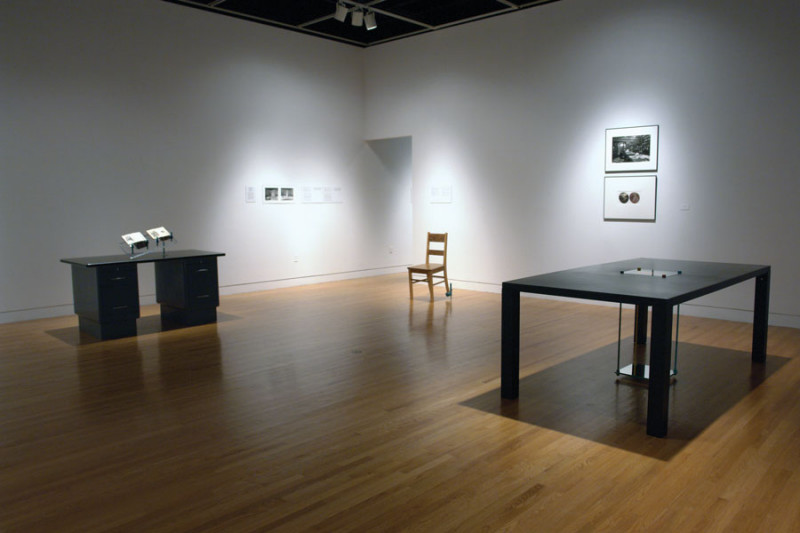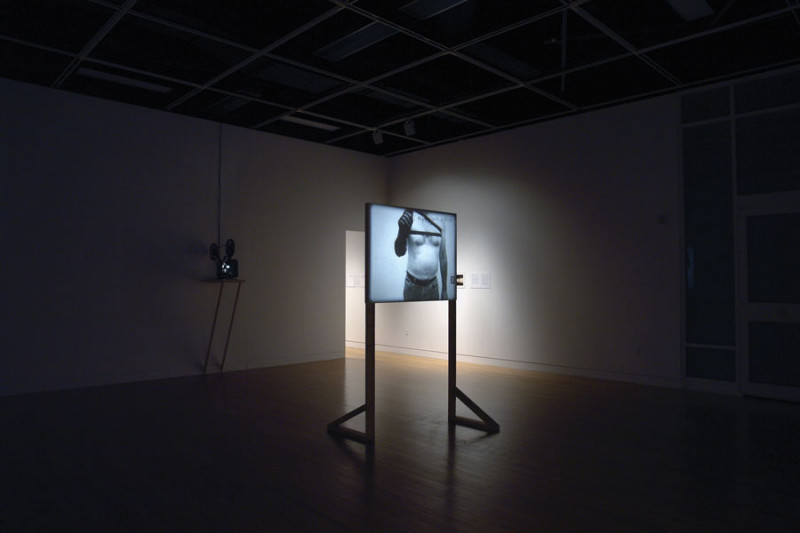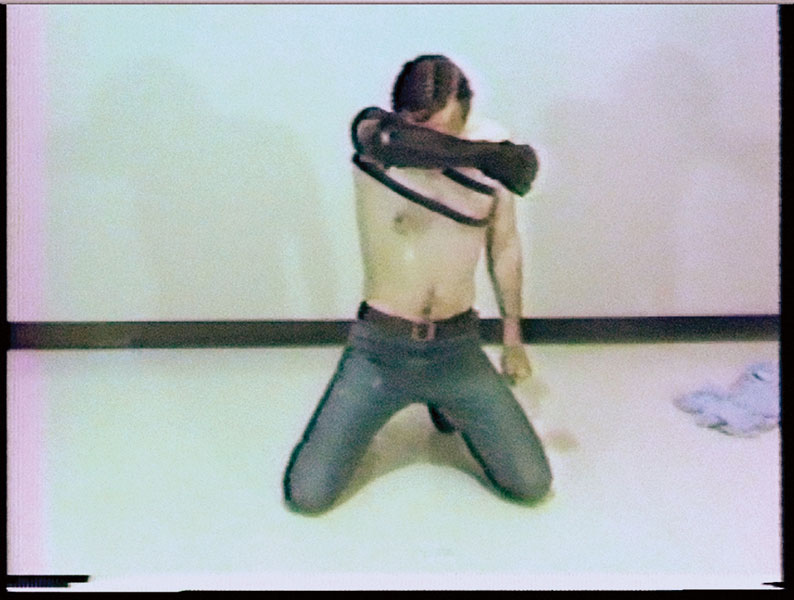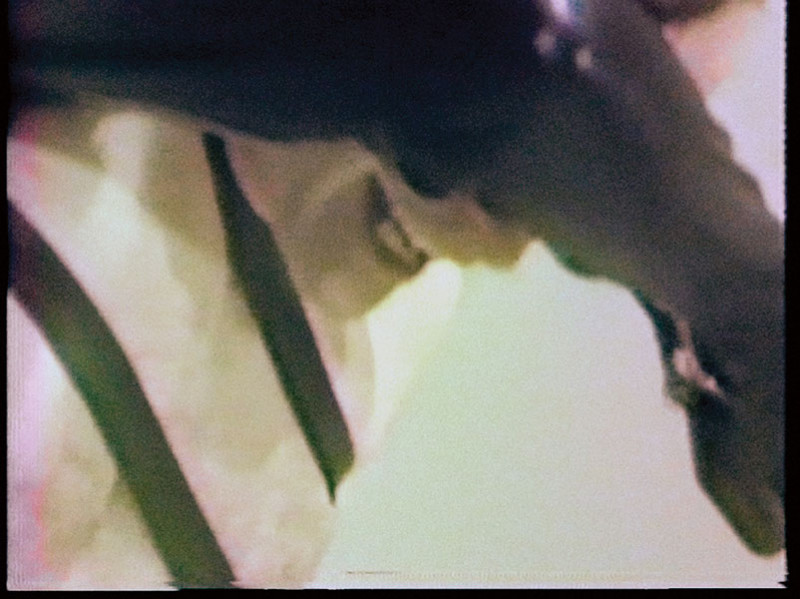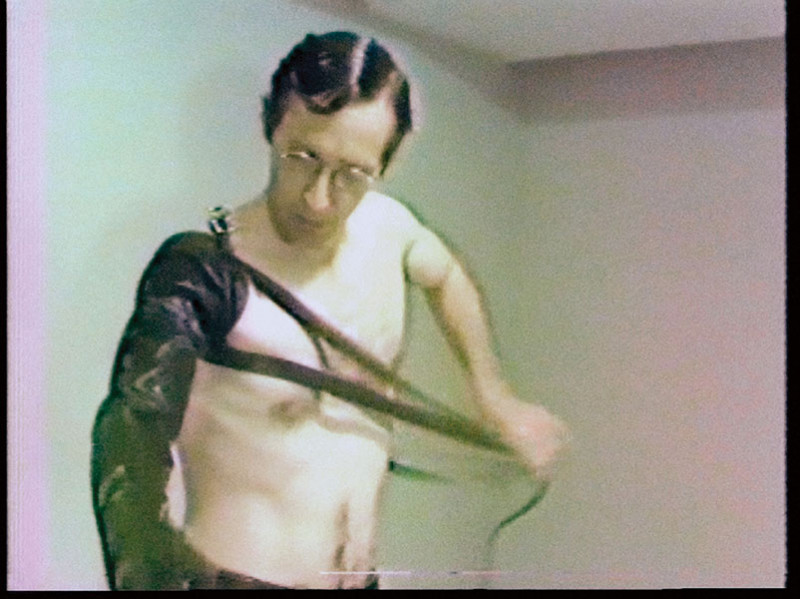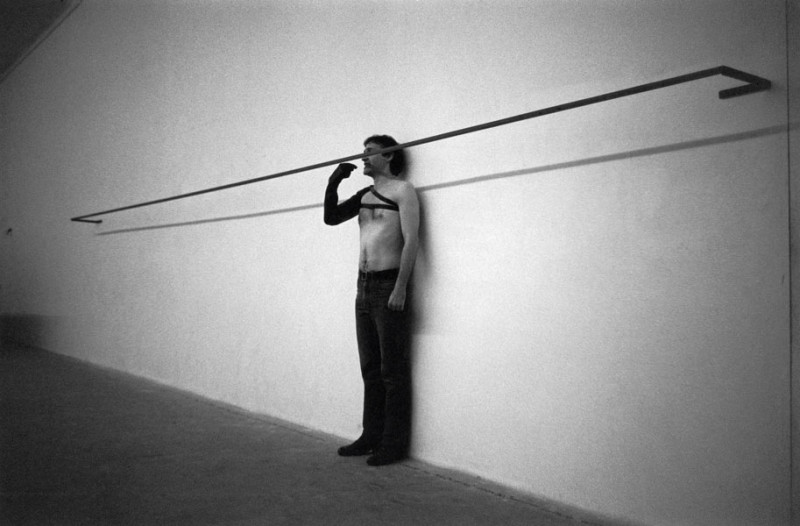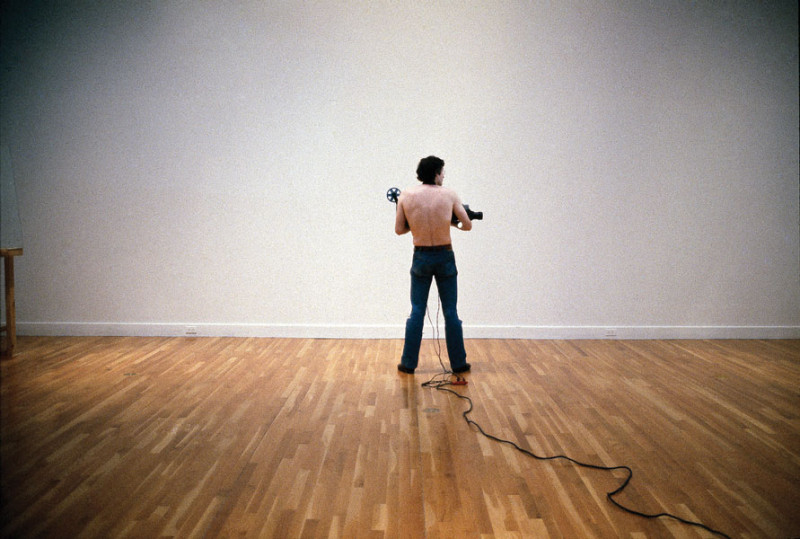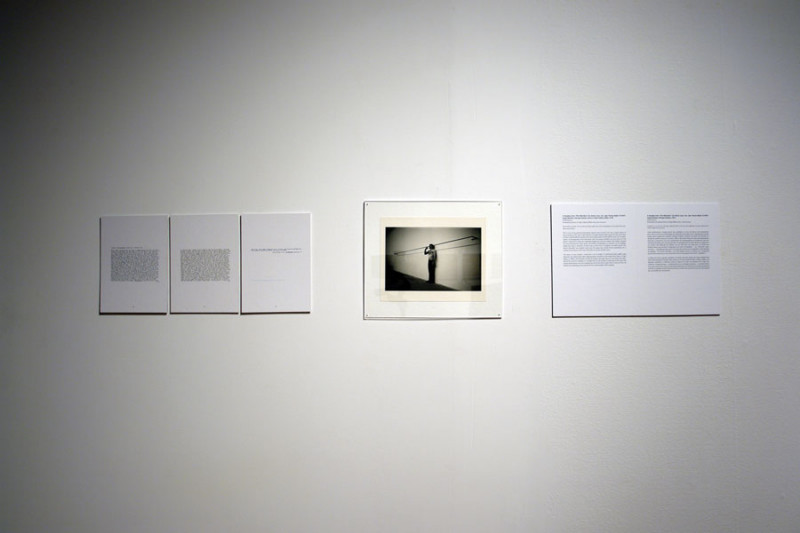[Fall 2010]
The exhibition “Tim Clark. Reading the Limits” was produced by the Leonard & Bina Ellen Art Gallery at Concordia University and presented from October 23 to November 29, 2008.1 On one level, the exhibition was a retrospective devoted to Tim Clark, a Montreal-based performance artist who produced a series of important works between 1977 and 2003. On another level, it was designed to reopen the question of the contemporary status of the artist and the interstitial – post-1970s/contemporary academic – function of the artwork. The exhibition therefore presented Clark’s work in retrospective fashion, but, through its logic and design, it also actively explored the contemporary status of the artist, the function of the artwork, and the role of the spectator.
by David Tomas
Clark’s work is rooted in the discipline of philosophy – in particular, ethics. His work indirectly raises questions about the nature and function of art: its conditions of existence, its capacity to generate knowledge, its social and political functions, and its limitations; it also fosters questions about the university’s role in aligning and gearing the activities of the artist, curator, and viewer in order to transform them into complementary and productive components in an art system economy. The work is of contemporary interest because of its innovative and challenging performance-based propositions about the nature and limits of art in an era dominated by the academicization of avant-garde art practices and their transformation into the products of a professional, economically disciplined culture of knowledge production.
One of the exhibition’s mandates was therefore to highlight the pertinence and stimulating possibilities of complex, intellectually engaged, limit-based post-conceptual visual propositions and experiences. Another was to highlight alternative social functions for the artist and models for the artwork that are distinct from entertainment- and manual skill-based models.
The problems associated with presenting “Tim Clark. Reading the Limits” were substantial, since the major portion of the artist’s work was performance-based and therefore ephemeral in nature. Clark’s “archive” consisted of three table-based performance installations, a book-object, a series of wall works, and limited photographic and videographic documentation. These elements constituted the exhibition’s visual and conceptual raw material and its research matrix. An analysis of Clark’s work exposed a practice that pivoted on print culture – in particular, readings, citations, or books presented in the form of performances, installations, and object-based “performance works for the audience.”2 Because of the textual and citational nature of Clark’s work and the fact that he defined the spectator’s engagement with the artwork in these terms, it was decided to organize the exhibition around his use of books and texts. Moreover, it was through this organizational logic that his practice could be linked to the question of the university’s mid-to-late-twentieth-century role in redefining the artwork’s knowledge matrix and its function of cultivating a new academic status for the artist.
If the book-based culture of the university is acknowledged as the new foundation for knowledge production in the art world today, then it might be possible to trace out another history of contemporary art that takes account of this new frame of reference and its information economies. Early practitioners of conceptual art indirectly explored important facets of the university’s information- and knowledge-generating culture through their use of such “new artistic media” as the index card, the photocopy, and the scholarly book. A particularly interesting example is Joseph Kosuth’s Information Room (1970); a later example is the Vito Acconci Studio’s Info-system/bookstore for Documenta X (1997). Clark’s performance-based approach represented a different, yet complementary, exploration of the university’s culture of knowledge and its impact on the visual arts.
Two design strategies were adopted in the exhibition design to encourage the viewer to enter into a performative/textual relationship with Clark’s work, the culture of his practice, and the questions that they suggested. The first was the deployment of original works throughout the exhibition space that were linked directly (by reference) or indirectly (through proximity) to text panel modules. This created a reciprocal reading experience that was doubly articulated in space and along the walls. But it also created, in the context of his table-based works that incorporated books, a productive relationship with them, in which the viewer could, in Roland Barthes’s words, step out of the conventional role of consumer of texts(a readerly activity) to become an active performer and therefore “a producer of the text” (a writerly activity).3
The second design strategy concerned the composition of the text panel modules that were deployed in a linear fashion along the walls of the gallery. This conventional mode of presentation was chosen because of the complexity of Clark’s work, which demanded a straightforward approach to the exhibition’s layout, and also to encourage and reinforce an initial readerly engagement with Clark’s work, which could then be strategically counteracted through the triggering of writerly experiences. The text panel modules were composed of three elements, the first and last operating as brackets to highlight and contextualize a visual document (a vintage photograph or a copy). The first element, an innovation in relation to the exhibition catalogue, consisted of an actual catalogue page that contained basic information on the work. The last element consisted of the artist’s written description of the work, its objectives, and the issues implicated in its production. This juxtaposition of catalogue page and artist’s description in his own words created a dynamic interrelation of curatorial and institutional presences (a readerly register) with the “voice” of the artist as represented by a printed description (a writerly register). The interrelation was augmented and enriched by the sound of the artist’s voice, as recorded in the only two video documents that existed, projected throughout the exhibition space. These elements dynamized the visual document and interlaced with each other through it. This process could take place only through the active writerly mediation of the viewer. Moreover, the use of actual pages from an exhibition catalogue created a direct interface with that book-like object (since it was designed as a book and not simply as an ancillary exhibition document), thereby reinforcing the exhibition’s underlying roots in a culture of books, texts, knowledge, and passive and active reading practices. However, since the font size and style were different in each element, the viewer also entered into a spatial and temporal (narrative) relationship with each text panel module. As the viewer passed through the exhibition, he or she was constantly sensitized to the performative dimensions of a readerly-writerly experience actively cultivated by the exhibition design. This book- and text-based strategy of creating a dynamic quasi-linear narrative pathway through “Reading the Limits” encouraged the viewer to physically, conceptually, and intellectually enter Clark’s world and duplicate the readerly-writerly activity that was also so central to his practice. The duplication generated a dynamic spectatorial experience. Finally, structuring the exhibition in terms of texts and readerly-writerly experiences could encourage the viewer to engage implicitly or explicitly with the question of the geared social and academic functions of the artist and artwork and their relationships to the production and consumption of different forms of social and cultural knowledge.
The success of an exhibition such as “Reading the Limits” depends on how one chooses to focus on an art practice’s underlying cultural logic, and how this practice is dynamically rearticulated in an architectural space. The tighter, more intellectually coherent the practice, the more compact is the works’ basic cultural logic. The more concise the work, the more aligned is its cultural logic with the logic that operates in the subculture or culture to which it belongs. The singularity of Tim Clark’s work resides in the way that it re-articulates book-based knowledge at a moment when art education and practice have shifted from vocational toward professional academic criteria of production. In the 1960s and 1970s, the art world moved decisively away from manual (handmade) skill-based practices to intellectual book-based practices. “Reading the Limits” was designed to achieve a parallel form of re-articulation in relation to the Leonard & Bina Ellen Art Gallery, which is situated in the building that also hosts the Webster Library, Concordia University’s principal library. The relationship between library and exhibition was reinforced through the presence of incidental references (borrowed and displayed library books) and by the fact that Clark worked and taught at Concordia University for most of his life, and his interest in books and philosophy had been cultivated within its walls. This nesting of functions, spaces, and roles was the invisible multidimensional frame of reference for the viewer’s experience of the exhibition and for the triggering of a sequential, intervallic spectatorial condition of self-reflection and questioning.
1 The exhibition was curated by David Tomas with the collaboration of Michèle Thériault and Eduardo Ralickas. The catalogue was edited by David Tomas and Michèle Thériault and contained extensive essays by Eduardo Ralickas and David Tomas.
2 E-mail communication with the author, 12 June 2008. The important role of reading in Clark’s work is clearly signalled, for example, in the titles of his late-1970s performances, A Reading from “The Story of the Eye”, by Georges Bataille, (1978); A Reading of “On Obedience and Discipline,” from The Imitation of Christ, by Thomas à Kempis (1979); A Reading from “The Bikeriders” by Danny Lyon, Cal., Age Twenty-eight, Ex-Hell’s Angel Member, Chicago Outlaws (1979); and A Reading of the Lord’s Prayer (23rd psalm) (1979). In each of these performances, Clark read a text aloud. The role of reading was transferred to the viewer in Clark’s installations of the early 1980s, and this relationship was cultivated in his 1990s table/book-based installations.
3 Roland Barthes, S /Z, translated by Richard Miller, preface by Richard Howard (New York: Hill and Wang, 1974), p. 4. See, for example, Clark’s table/book-based “performance works for the audience” [1] Veit & Comp., Berlin, 1845/1847. [2] Presses Universitaires de France, Paris (1991) and Deipnosophistae (1993). See also the installation John 15: 2-3, An Anonymous Letter (1981).
David Tomas is an artist and writer. He has exhibited in Canada, the United States, and Europe and held visiting research positions at CalArts, Goldsmiths College, the University of London, and the National Gallery of Canada. He is the author of Beyond the Image Machine: A History of Visual Technologies (2004), A Blinding Flash of Light: Photography Between Disciplines and Media (2004), and Transcultural Space and Transcultural Beings (1996). Tomas is currently finishing a book on the relationship among Dziga Vertov, Michael Snow, and Harun Farocki for NSCAD University Press. He teaches at the École des arts visuels et médiatiques, Université du Québec à Montréal. Web site: http://www.er.uqam.ca/nobel/dtomas/
Tim Clark studied analytic philosophy before turning to the visual arts in the late 1960s. His interest in philosophy has imbued his body of work, with influences from conceptual art, minimalism, and performance. He earned master’s degrees in visual arts and history of art from Concordia University in 1982 and 1986, respectively, and in 1997 he became a professor in the university’s department of visual arts, where he is still teaching. Since 2003, he has been devoted to academic research.


